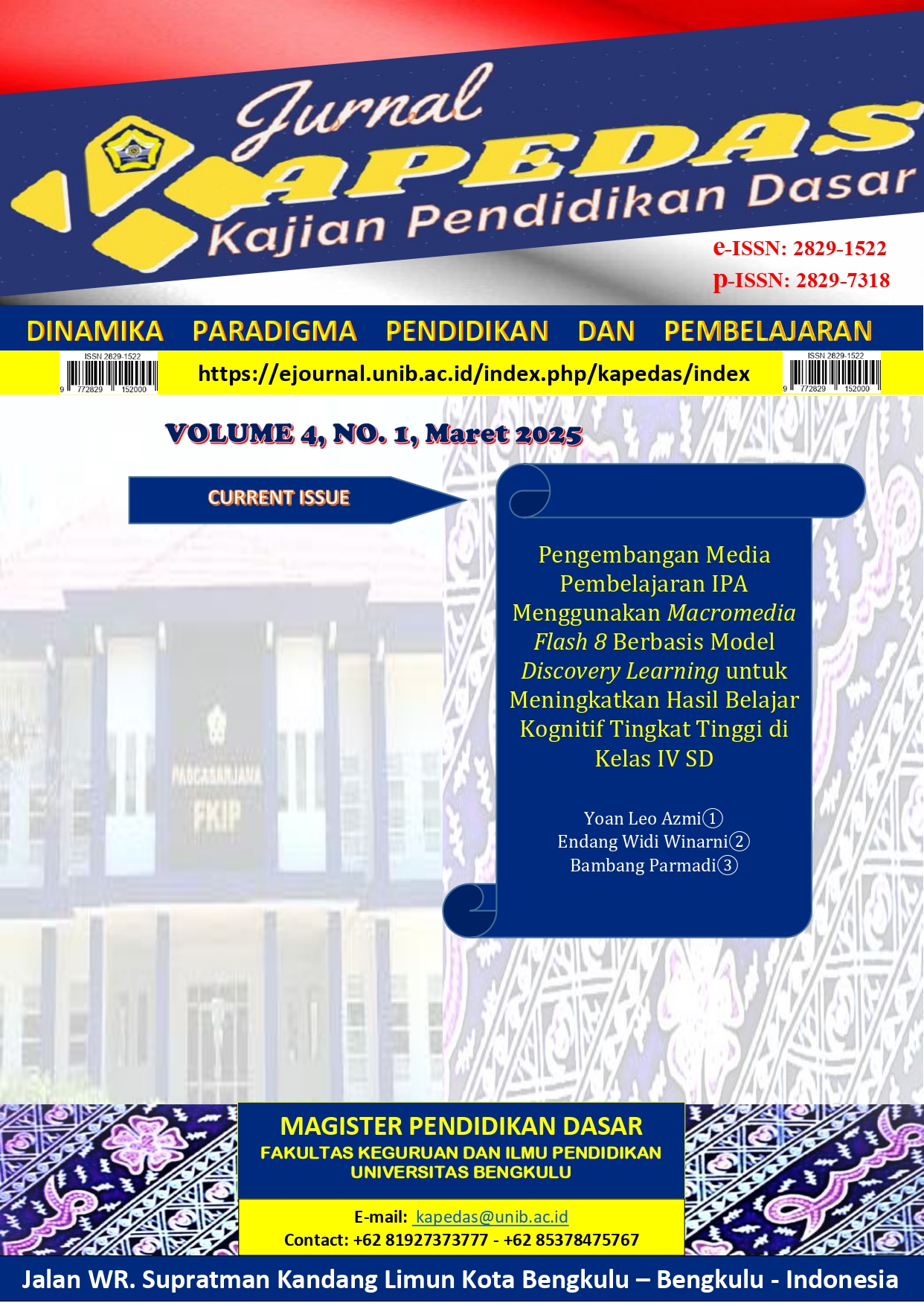Main Article Content
Abstract
The purpose of this research is to analyze the influence of IPAS learning using the Project Based Learning model assisted by the Robot Education Box media on the ability to think fluently, flexibly, and originally. The type of research used is quasi-experimental research employing a pretest-posttest control group design. The type of data used is quantitative data, utilizing a questionnaire instrument and expert validation sheets. Based on the research results, it was found that the implementation of IPAS learning using the Project Based Learning model assisted by the Robot Education Box media has a significant effect on fluency thinking skills. This is demonstrated by the average posttest score for fluent thinking ability in the control class, which is 37. Meanwhile, the average score for the experimental class is 88. The implementation of IPAS learning using the Project Based Learning model assisted by the Robot Education Box media has a significant impact on flexible thinking ability. This is shown by the average posttest score of flexible thinking ability in the control class being 28, while the average score in the experimental class is 71. The implementation of IPAS learning using the Project Based Learning model assisted by the Robot Education Box media has a significant impact on original thinking ability. This is shown by the average posttest score of fluent thinking ability in the control class, which is 33. The result of the correlation test shows that the flexibility and originality ability is 0.013, concluding that there is a significant relationship.
Article Details
Copyright (c) 2025 Nadia Elpa Meilanda, Endang Widi Winarni, Gumono

This work is licensed under a Creative Commons Attribution-ShareAlike 4.0 International License.

Karya ini dilisensikan di bawah Creative Commons Attribution-ShareAlike 4.0 International License .
References
-
Aulia, N. (2023). Penerapan Model Project Based Learning untuk Meningkatkan Kemampuan Berpikir Kreatif Siswa di Sekolah Dasar. Jurnal Riset Madrasah Ibtidaiyah (JURMIA), 3(1), 1–7
Illahi, P. C., Fitri, R., & Arsih, F. (2022). The Effect of Project Based Learning Model on Creative Thinking Ability in Biology Learning. Journal of Digital Learning and Education, 2(3), 171–177.
Kelana, J. B., & Wardani, D. S. (2021). Model Pembelajaran IPA SD. In Edutrimedia Indonesia (Issue February).
Nurla, A. I. (2011). Menerapkan Pendidikan Karakter di Sekolah. Yogyakarta: Transmedia.
Susanto, A. (2019). Teori Belajar dan Pembelajaran di Sekolah Dasar. Jakarta: Prenamedia.
Suradika, A., Dewi, H., I., & Nasution, M. I. (2023). Project-Based Learning and Problem-Based Learning Models in Critical and Creative Students. Jurnal Pendidikan IPA Indonesia, 12(1), 153–167.
Suryani, R. L., Sayekti, I. C., & Khanifah, S. (2022). Penggunaan Alat Peraga Robatar Untuk Meningkatkan Hasil Belajar Matematika Pada Siswa Kelas III. Educatif Journal of Education Research, 4(3), 336–343.
Ulolli Ritin. (2022). Menjadi Kritis dan Kreatif. Bandung: CV Media Sains Indonesia
Winarni, E.W., & Purwandari P. E. (2020). Project-Based Learning To Improve Scientific Literacy For Primary Education. Jurnal Prima Edukasia Vol.8(1), 67-77.
References
Illahi, P. C., Fitri, R., & Arsih, F. (2022). The Effect of Project Based Learning Model on Creative Thinking Ability in Biology Learning. Journal of Digital Learning and Education, 2(3), 171–177.
Kelana, J. B., & Wardani, D. S. (2021). Model Pembelajaran IPA SD. In Edutrimedia Indonesia (Issue February).
Nurla, A. I. (2011). Menerapkan Pendidikan Karakter di Sekolah. Yogyakarta: Transmedia.
Susanto, A. (2019). Teori Belajar dan Pembelajaran di Sekolah Dasar. Jakarta: Prenamedia.
Suradika, A., Dewi, H., I., & Nasution, M. I. (2023). Project-Based Learning and Problem-Based Learning Models in Critical and Creative Students. Jurnal Pendidikan IPA Indonesia, 12(1), 153–167.
Suryani, R. L., Sayekti, I. C., & Khanifah, S. (2022). Penggunaan Alat Peraga Robatar Untuk Meningkatkan Hasil Belajar Matematika Pada Siswa Kelas III. Educatif Journal of Education Research, 4(3), 336–343.
Ulolli Ritin. (2022). Menjadi Kritis dan Kreatif. Bandung: CV Media Sains Indonesia
Winarni, E.W., & Purwandari P. E. (2020). Project-Based Learning To Improve Scientific Literacy For Primary Education. Jurnal Prima Edukasia Vol.8(1), 67-77.
